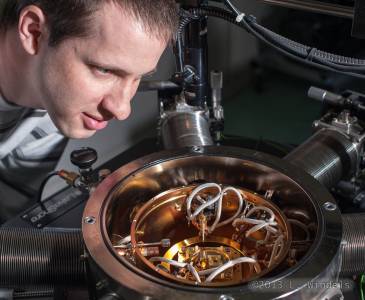Research topic

My topic focuses on the interaction between carbon nanotubes and ferroelectric thin films. This research in the nanotechnology field includes studying the electrical properties of carbon nanotubes at temperatures ranging from -269°C to over 100°C, and measuring the polarization of ferroelectric thin films using piezoresponse force microscopy, a variant of atomic force microscopy. I also use common scientific software such as LabVIEW, MATLAB and COMSOL Multiphysics to automate measurements or to analyze collected data.
More specifically, my area of research includes:
- Modulation of the electronic properties of carbon nanotubes with ferroelectric field effect
- One-dimensional transport in carbon nanotubes at cryogenic temperatures
- Nanoscale control of ferroelectric polarization using microscopy probes, patterned electrodes, and spin-coated carbon nanotubes
- Environmental and disorder effects on polarization switching in ferroelectric thin films
Teaching duties are part of my contract at the University of Geneva. I started as an assistant for a first-year course on mathematical programming (teaching of MATLAB and Maple software) and now supervise second-year students during their lab work. I am also in charge of supervising summer trainees and take part in occasional outreach activities such as lab tours, the Nuit de la Science exhibition and workshops for secondary school teachers.
Publications
I am the first author of three publications (see descriptions below) in the scientific journals Applied Physics Letters and New Journal of Physics. My articles are also freely accessible on arXiv and other websites.
-
Minimum domain size and stability in carbon nanotube-ferroelectric devices (arXiv)
This article presents a study on the minimum domain size one can switch using carbon nanotubes as electrodes in ferroelectric Pb(Zr0.2Ti0.8)O3 thin films. These results are compared with studies using other types of electrodes, numerical simulations using COMSOL Multiphysics and theoretical models available in the scientific literature.
-
Understanding polarization vs. charge dynamics effects in ferroelectric-carbon nanotube devices (arXiv)
This article is a comparative study of carbon nanotube-based field effect transistors using either a ferroelectric or a dielectric material as gate oxide. The ferroelectric field effect is highlighted by comparison between the two systems and studied at temperatures ranging from 269°C to room temperature. At low temperature, fluctuations originating from quantum interferences are observed.
-
Subcritical switching dynamics and humidity effects in nanoscale studies of domain growth in ferroelectric thin films (arXiv)
This article presents a study of the impact of humidity on the growth of atomic-force-microscopy-tip-induced ferroelectric domains. The results show that within ordinary laboratory conditions, the size of written domains increases linearly with rising humidity, with a difference of a factor of two between dry and humid environments. The second part of the article focuses on the effect of subcritical voltage pulses (pulses which are too short to induce by themselves a full ferroelectric switching). The consequence of repetitions of such pulses highlights a surprisingly long relaxation time on the order of 100 ms of the polarization state after a subcritical pulse.
My PhD thesis entitled "Probing nanoscale limits of polarization switching and controlling electronic properties in devices combining CNTs and ferroelectrics" is available online on the open archive of the University of Geneva.
Conferences
I have presented my results either as talks or as posters at various conferences, including:
- E-MRS Spring Meeting 2010 (Strasbourg)
- Annual Meeting of the Swiss Physical Society 2010 (Basel)
- Swiss Workshop on Materials 2011 (Les Diablerets)
- International Conference on the Science and Application of Nanotubes 2011 (Cambridge)
- Annual Meeting of the Swiss Physical Society 2012 (Zurich)
- PFM Symposium 2013 (Prague)
- Workshop on Piezoresponse Force Microscopy 2014 (State College / USA)
